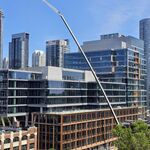Thoughtless Miscreant
Active Member
correct me if I am wrong but did Ford not say that Finch West measures would be replaced by a subway in ~10 years?
I believe he said it, but it's completely impossible.
correct me if I am wrong but did Ford not say that Finch West measures would be replaced by a subway in ~10 years?
Less people would use it if it were along the hydro corridor. It would be an extra 400 m to 500 m walk to get to Finch Avenue from the hydro corridor, not great for the elderly without a scooter.
Justin10000 said:pfft!! Who cares about the local riders? Riders from Mississuaga have to get to Scarborough, dammit!
And on the flip side, the TTC should focus only on making stops so close together, that it becomes tedious and worthless at moving people any kind of distance and is exclusively used as a social-engineering tool to spur high density developments where things are so close together, there is no need to take the bus anyways. I mean, who would ever think of using transit being used to actually transport people across distances too far to walk?
You are underestimating the walk people already endure through the various cul-du-sacs to get to the bus.
No, I'm saying they need to find a cushy medium, about 1 to 2 km between stops. I'd also wager that slow service which takes 3 times longer than driving to get anywhere influences more car purchases than an "unbearable" 10 minute walk to a bus stop. Besides, are we trying to get cars off the road, or pedestrians off the sidewalk?So instead the TTC should focus on making stops so far apart, it becomes a tedious task to walk to a stop, just to accommodate a much smaller number of inter-regional trips. This is the sort of scenario that pushes people to buy cars. What's the point in the fastest trip if a rider has to walk 1km to a stop?
No, I'm saying they need to find a cushy medium, about 1 to 2 km between stops. I'd also wager that slow service which takes 3 times longer than driving to get anywhere influences more car purchases than an "unbearable" 10 minute walk to a bus stop. Besides, are we trying to get cars off the road, or pedestrians off the sidewalk?
On a side note... I was told that transit causes sprawl as well big box malls, any thoughts?
No, I'm saying they need to find a cushy medium, about 1 to 2 km between stops. I'd also wager that slow service which takes 3 times longer than driving to get anywhere influences more car purchases than an "unbearable" 10 minute walk to a bus stop. Besides, are we trying to get cars off the road, or pedestrians off the sidewalk?
Which is why the 97 Yonge actually exists as it overlaps the subway since the Yonge North extension stations were 2km apart to save money. Efficiency loses as stop distance increases and the higher the need of an overlapping, redundant route goes.1 - 2km is not a cushy medium ...
iirc, I had a reply somewhere that it would be illegal from the MTO to have road passenger vehicles with higher passenger capacity than regular artics... Still, Finch may even have capacity to run bi-articulated busses.
http://en.wikipedia.org/wiki/File:Bus_Stops_3_curitiba_brasil.jpg
Which is why the 97 Yonge actually exists as it overlaps the subway since the Yonge North extension stations were 2km apart to save money. Efficiency loses as stop distance increases and the higher the need of an overlapping, redundant route goes.
As with the 85 Sheppard Bus, and I assume the 34 bus route would be retained to overlap the new underground section. It's an inefficient use of resources just to shave a few minutes from the travel time.




